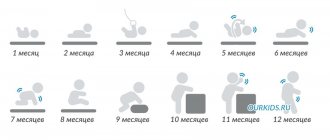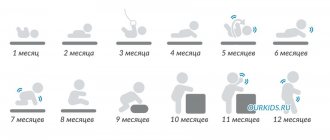Your baby is 3 months old. By this time he had developed a strong attachment to his parents. He responds with a smile, cries and sleeps less, and you can notice the first characteristics of the little man’s character. The baby has adapted to the new world, and his daily routine has become more organized and predictable.
All children grow at different rates. In the article we provide approximate stages of development that you should pay attention to. There is no need to worry if your baby does not meet these criteria exactly. In some ways he may now be ahead and in others behind his peers. Over time this will even out.
Physical development and new skills
At 3 months the child becomes much stronger physically. Almost every week, parents notice changes in their baby’s development.
During this period, the child has already learned:
- hold your head up independently;
- raise and hold your head for a long time while lying on your stomach;
- support the upper body with your hands while lying on your stomach;
- stretch your legs and kick while lying on your stomach or back;
- putting hands and toys into the mouth;
- holding a toy, shaking it, hand coordination is not yet developed.
Also, by 3 months, some babies’ fontanel has already closed. The pediatrician will definitely pay attention to this during a routine examination. If your baby's fontanel is still noticeable, there is no need to panic, it may close later. In the absence of other symptoms, this is not a sign of concern.
Height and weight
In the first year of life, children grow rapidly. According to WHO research, the average weight of a baby directly depends on the gender of the child. Boys, as a rule, are larger, but girls with maximum weight and height are not uncommon, but just an example of the fact that all people are different.
Average weight and height of children in the first six months of life:
| Age | Girls | Boys | ||
| Weight, kg | Height, cm | Weight, kg | Height, cm | |
| Newborn | 3 200 | 49.1 | 3 300 | 49,9 |
| 1 month | 4 200 | 53,7 | 4 500 | 54,7 |
| 2 months | 5 100 | 57,1 | 5 600 | 58,4 |
| 3 months | 5 800 | 59,8 | 6 400 | 61,4 |
| 4 months | 6 400 | 62,1 | 7 000 | 63,9 |
| 5 months | 6 900 | 64,0 | 7 500 | 65,9 |
| 6 months | 7 300 | 65,7 | 7 900 | 67,6 |
⠀
If your child is a little smaller or larger than normal, there is no need to panic. It is important that he grows and gains weight at a healthy rate. The pediatrician carefully monitors this, especially in the first year of the baby’s life. It is better for parents to refrain from regularly weighing their baby at home for the sake of everyone’s peace of mind.
Average head and chest circumference in children under 6 months:
| Child's age | Head circumference in cm | Chest circumference in cm | ||
| Boys | Girls | Boys | Girls | |
| 1 month | 37,3 | 36,6 | 36,3 | 36.0 |
| 2 months | 39,2 | 38,4 | 39,0 | 38,1 |
| 3 months | 40,9 | 40,0 | 41,3 | 40,0 |
| 4 months | 41,9 | 41,0 | 42,8 | 41,8 |
| 5 months | 43,2 | 42,0 | 44,3 | 43,0 |
| 6 months | 44,2 | 43,0 | 45,4 | 44,3 |
⠀
New skills
Basic skills that are developed by 3 months:
- ability to roll over from back to side;
- the ability to raise the head and shoulders with support on the forearms;
- holds the head and controls it;
- recognizes the faces of mom and dad;
- laughs when communicating;
- is capricious and whining;
- grabs the toy and pulls it into the mouth;
- hums, coos;
- hits toys hanging over the crib with his hands;
- rests his legs on a hard surface with support under his arms.
There are no strict rules on this issue either. Some babies perform all these actions already at three months, while others begin to make their first attempts only closer to 4-5 months. Each little person has his own speed of development, so if the baby is healthy and does not have any neurological problems, he will definitely learn to roll over and lift himself up (when children begin to roll over).
By the way, the process of mastering new skills can be speeded up a little. The following tips will help parents with this:
- Add an exercise that stimulates inversions to your standard daily gymnastics. The baby lies on his back, his right leg needs to be lifted, holding it by the shin, and led to the left, as if throwing it over the body. This moment during a rollover is the most difficult for a child, because it is this moment that gives the whole body the impulse to perform the movement. Later, children learn to push off from a horizontal surface themselves.
- Conscientiously perform the entire range of exercises recommended by pediatricians. The basis of all new physical skills is the overall good development of the baby’s body and muscles.
- You can promote the development of the second skill in a very simple way: regularly place your baby on his stomach. To make lying in this position interesting, place bright toys in front of him. An excellent option for this age is a developmental mat. The baby will not be bored on it either on the back or on the tummy. Many rugs have a small round mirror included. Looking at your reflection there while lying on your stomach is a fascinating activity.
Detailed article: What a 3 month old baby can do
Another tip concerns safety: after the baby has learned to roll over, do not leave him alone on high surfaces (on the sofa or changing table). The baby may fall and get injured. If you need to leave the room, put your baby in a crib or chaise lounge.
Read also: How to teach a child to roll over
What should a 3 month old baby be able to do?
At 3 months the child becomes outwardly more harmoniously formed. It is important for parents to know the main indicators in order to help the baby develop, and in case of health problems, to quickly notice that something is wrong.
Reflexes
By 3 months, the following reflexes fade away in the child:
- Search reflex. If you stroke your baby's cheek or corner of his mouth, he will turn his head in your direction and open his mouth slightly.
- Babkin reflex. If you press your thumbs on both palms of the child, he will open his mouth and bend his head.
- Pronounced Moro reflex. When hitting a surface near the child, the baby spreads his arms and clenches his fists, after which they return to their original position.
- Proboscis. A child stretches out his lips with his trunk if you touch his upper lip.
If these reflexes remain in the baby after 3 months, this may indicate developmental disorders and problems with the nervous system.
Physical activity
Physically, the child is already trying to control his movements, holding his head well in a vertical position. When trying to lift him onto his arms, he tilts his head forward. The range of movements of the limbs increases noticeably.
Changing diapers will now be more fun and longer. The baby has acquired a new physical skill - he has learned to kick with both legs at the same time, and this greatly amuses him. At this time, the baby begins to strongly wave his arms and legs, and can hit objects nearby with his fists.
In addition, at 3 months the baby already begins to rock back and forth, so be careful: do not leave him unattended either on a changing table or on a bed without a side.
Development of the body and organism at three months
Height and weight
Every month, parents and their baby visit the clinic to monitor the child’s development, as well as changes in height and weight. There are approximate standards for weight and height. They depend on the data that was at birth. The estimated weight of a three-month-old baby can be from 3 to 6 kilograms, and its height can be from 54 to 64 centimeters.
Height and weight indicators are directly influenced by the method and type of nutrition, as well as genetic inheritance. There are approximate tables for a child’s weight gain and height. But they cannot be taken as a basis, since individual characteristics must be taken into account, firstly. And secondly, these numbers will differ significantly between breastfeeding and artificial feeding. With breastfeeding and high-quality breast milk, a child can gain weight from five hundred grams to two kilograms per month. The baby himself will determine when he is full; it is impossible to overfeed him. The main thing is to let him eat as much as he wants.
Some mothers are worried about the large discrepancy between the data in the table and the height and weight of their baby. Children cannot all be the same developmentally. Observe your baby during the day, how he eats, sleeps, plays, pees and poops, and what the condition of his skin, hair and nails is. If everything is fine physically, the child is not capricious and active, then there is no need to worry.
Reflexes at three months
Certain instincts and reflexes appear in a baby from the first day of life, and by three months some of them should fade away. If they do not go away, then this may indicate certain pathologies associated with the nervous system:
- Try to lightly touch the corner of the baby's mouth with your finger; he may turn his head in this direction and open his mouth. This reflex is called the search reflex;
- When you lightly touch the child’s upper lip, he forms something like a proboscis with his lips - this is the proboscis reflex;
- If you lightly press your finger into the middle of a child’s palm, the child lifts his head forward and at the same time opens his mouth - this is the Babkin reflex.
The sucking and crawling reflex only become more active at this age, because they are an integral element of the baby's development. And there is also one protective reflex in a child that can persist for a certain time. When laying the baby on his back or while raising his legs above the support, the fall protection reflex is triggered. At this moment, the baby spreads his fingers to the sides and throws up his arms - this is the Moro reflex.
What should you be able to do?
The word “should” is not very suitable here, since each baby develops at its own speed. It’s just that some do it faster, while others do it a little later. What one person does perfectly at three months, another can start at four. There are no strict standards in this matter. The main thing is that the neurological condition is normal, and skills and abilities will definitely be formed.
Physical skills
- The baby can confidently lie on his back for a long time; he does not need support.
- The child reacts to the toys hanging above him, tries to reach them and touch them with his fingers. He can look at objects for a long time, as well as his legs and arms, and pulls them into his mouth.
- The baby reacts to voices and sounds by turning his head and looking at him. He watches with interest the movement of bright toys.
- A three-month-old baby independently turns from his back to his side and to his tummy. While learning this skill, the baby also pushes off with his legs from a nearby support (for example, from the side of a crib).
- Leaning on his not yet strong forearms, the baby tries to stay longer on his tummy and look at the world around him, raising his head and legs. This procedure is useful for strengthening the back muscles, which will later help you sit, stand and walk independently.
- The child easily moves in the horizontal plane of the crib. With the help of the movement of its arms and legs, it changes its position in one direction or the other, and it does this in just a few minutes. Such movements will be useful in mastering crawling skills in the future.
- Try to place the baby (supporting him, of course) with his legs on a flat surface and he will definitely start to push off from it. This indicates strengthening of the leg muscles.
- A child at this age tries to connect his fingers into a lock and bring his arms together. You can start learning to clap your palms (the game “Platushki”).
Detailed article: What a 3 month old baby can do
Emotional achievements
- At the age of three months, parents notice that the child begins to show his character and emotions.
- Positive emotions in the baby manifest themselves in the form of smiles, laughter and even squeals. This is how he can react to the appearance of close people or well-known pets. But he may cry and get scared when strangers and strangers appear.
- By the nature of the sounds made by the child, one can already distinguish his desires. When left alone for a long time, whining can be heard to attract the attention of adults. The baby may be lonely and bored, he needs to be held by his mother or just to see his own face and hear his own voice. If you don’t pay attention to the whining, it will develop into loud crying - a demand. But it’s worth giving your baby a few minutes, and sometimes just appearing in his eyes, and he will calm down.
- The baby is trying to pronounce sounds that consist not only of vowels, but also of consonants. His first speech skills are formed. Start talking or singing to him and he will respond in his childish language. Children really like such “conversations”.
- Most children have a positive attitude towards bathing. At this age, they are ready to splash in the water all day long. Splashing water with your arms and legs gives you special pleasure.
Advice for young parents
A child at any age, at any stage of development, needs parental attention and praise. Praise your baby more often, for the smallest achievement.
For safety reasons for the life and health of the baby, never leave him unattended on high surfaces (for example, on a bed or on an ottoman, on a changing table). Just a few minutes without adult attention can result in a child falling and causing serious injury. A crib is one of the safest places for a baby.
About basic needs: sleep and nutrition
Each child has different rest needs, but on average, a baby at this age needs 14-16 hours of sleep per day, including naps.
The child’s daytime sleep schedule should already become familiar to everyone at home. Most 3-month-old babies sleep several times during the day for 1.5-2 hours.
Generally accepted sleep standards for a 3 month old baby:
| Total per day | Night sleep | Daytime nap | Maximum time awake between sleeps | |
| Number of hours of sleep | 14-16 | 9-10 hours with waking up for feedings | 4-5 hours (for the whole day) | 75-90 minutes |
⠀
Some people are already starting to sleep at night for 5 hours straight, others are waking up frequently. This can happen for various reasons. For example, if your baby is breastfed, he will wake up more often to snack.
Also, the child may wake up when sleep phases change. Don’t rush to run to his room, give the baby a few seconds. As a rule, wakefulness in this case is short-lived and the baby will immediately fall asleep again on his own.
The colic period should have lost ground by this time. And you can notice with relief that the child has stopped waking up restlessly and crying.
Healthy and sound sleep
At 3 months, you may notice that the baby begins to sleep well only when moving in a stroller or in mother’s arms. That's why it's critical to establish healthy sleep habits now. Be sure to introduce rituals into your life before daytime and nighttime sleep. This could be reading books, a lullaby, a relaxing bath, dim lights and an environment conducive to sleep. Do not forget to ventilate the room more often and maintain humidity where the baby sleeps.
It is important during this period to improve your baby’s sleep so that over the next month you can painlessly shift bedtime to 20:00-20:30. At the same time, it is important that the baby always wakes up at the same time - 7-8 in the morning. This routine will allow you to create a healthy and physiological daily routine for the whole family in the future.
Diet and norms
For the first 6 months, all your baby needs nutritionally is breast milk or formula. If you are exclusively breastfeeding, consult with your pediatrician about the dose of vitamin D required for your baby. As a rule, for healthy children the daily requirement is up to 10 mcg.
Most babies surprise their parents with a growth spurt during this period, so you may notice that your little one is eating significantly more. On average, a three-month-old baby needs 720-1200 ml of milk (this is 5-8 feedings per day).
For breastfed children, a regimen of six daily meals is recommended: every 3-4 hours. It is important not to let your baby overeat so that he does not get a stomach ache. If the baby is artificial, it is preferable to feed him every 3-3.5 hours during the day; at night the break should be up to 6.5 hours.
Nutrition
The volume of the stomach increases and the baby needs more milk or selected formula. He is no longer tormented by stomach cramps, which makes him calmer. However, the child is not yet ready for the introduction of additional nutrition other than milk. To prevent rickets, your doctor may prescribe vitamin D.
If the baby is breastfed, it is carried out at his request. The interval between feedings increases and is 2.5-4 hours. The average number of breastfeedings during the day is 10-12 and at night - two to four times . During the feeding process, the baby already comes off the breast and takes short breaks.
In the case of feeding with milk formulas, a meal schedule is established: six to seven meals at intervals of 3.5 hours. At this age, the volume of formula eaten per day is 800-900 ml, 150-180 ml per feeding.
Sense organs and emotions
By 3 months, the baby’s organs of hearing, vision, smell and touch continue to actively develop.
Vision
Vision at 3 months is rapidly improving, although it is still far from normal. The baby begins to carefully and even, as it may seem, meticulously examine those around him, especially to peer into the faces of the people nearby. At the sight of relatives, the child is noticeably animated, laughing and cheering.
The child can focus on a toy located 20 cm from him and follow its movement with his eyes. To develop this skill, you can hang a mobile above your baby’s crib.
Hearing
The baby's hearing improves every month. He reacts to sounds in different ways: to loud and sharp ones - he will respond by crying; Hearing familiar steps or voices, he will begin to worry or perk up. At 3 months, the child must already turn his head in an attempt to find out where this or that sound is coming from.
Communication and emotions
This period can be characterized in a few words: constant eye contact, smiles, gestures and laughter.
By 3 months, the child begins to experience emotions and has a greater need for communication. Kids react to your voice, to various expressions, and look for their mother if she has disappeared from their field of vision. At this age, children begin to laugh. They already know exactly who is “their own” and who is the “stranger,” but they can also make a stranger they like happy with a smile. They no longer recognize people by their voice, but by their appearance and smell.
The baby communicates with adults with noticeable pleasure. He loves to be played with and can even cry with frustration if the fun is over.
The child learns to respond to you, gurgles a lot and makes more and more new sounds.
A baby at 3 months is more sensitive and can pay attention to some object longer. As the muscles develop, the baby begins to reach for objects that interest him. And although he has not yet learned to control his hands, he already has a noticeable desire to put something in his mouth.
What to do with your baby: games with your child
During moments of active wakefulness, the baby is no longer interested in just lying in the crib. An inquisitive toddler strives to see and hear something new and interesting.
Games at this age are quite simple and short. It's great if the game is accompanied by a fun nursery rhyme or just a poem. The fact is that at 3 months speech begins to develop. The child makes the first sounds, which in scientific language are called pre-speech vocalizations. These are long vowel sounds: u-u-u, a-a-a, uh-uh. For the full development of speech, it is simply necessary to hear words and sounds. Folklore works are perfect for babies, because they were specially composed by our ancestors and are always chanted.
As part of the game, you can do finger exercises, massage the palms and feet, or invite the baby to touch different textures (pieces of fabric, cereal, etc.) with his hand. Playing with a rattle is also a great option for 3 months.
You can invite your child to look at large pictures in a book, making sure to pronounce and name all the objects and details. The pictures themselves for this age should be very sketchy and simple.
Communication with your child is important not only during games. Conversations with your baby must accompany every contact with him, be it getting dressed for a walk or changing a diaper. The speech should be emotional and calm. For a child, this is not only a way of development, but also an indicator of mother’s love and acceptance, and this is even more important than new information and skills.
← 2 month 4 month →
Advice from Dr. Komarovsky
If you follow the advice of a famous pediatrician with 40 years of experience from the very birth of your child, you can not only raise your baby correctly, but also make your life much easier. We offer some advice from Dr. Komarovsky for parents of three-month-old babies.
Dummy
At 3 months, the child's sleep should improve. If this does not happen, and the baby is not familiar with the pacifier from birth, young parents strongly offer the baby a pacifier for reassurance. Sometimes this method works, sometimes it doesn't.
The opposite situation: a baby who has been friends with the pacifier since birth is trying to separate it from it at the age of 2-3 months. However, the sucking reflex, the doctor says, is extremely important in a baby’s life for many reasons. Here you should rely only on the desire and health of the baby: there should be rationality and moderation in everything.
Rules for healthy sleep
If you still haven’t started getting enough sleep at night with your baby, and his sleep is interrupted and restless, this does not mean that the child has health problems. Normal sleep is the result of fulfilling several important conditions. Think about whether you are doing everything right. There are several simple rules for healthy sleep. Information about them in the video at the link:
Approximate daily routine
By this time, a certain daily routine has already begun to form, when feeding and sleep occur at approximately the same time of day. Sleep takes 16-17 hours a day and is distributed as follows: night sleep - 9-10 hours, one or two daytime naps for 1-2 hours, intermediate sleeps 30-40 minutes.
It is necessary to spend more time with your baby in the fresh air . It is recommended to take a morning and afternoon walk of two to three hours. You should not go for a walk only under extremely unfavorable conditions: severe frost, hurricane winds, rain. The walking time is not limited and depends on the parents’ capabilities.
On our website you can read articles about the development of a child at 1 month, the development of a child at 2 months, and the development of a child at 4 months.
Common problems and ways to solve them. When should you sound the alarm and when should you not?
In most cases, the baby’s parents are overly worried about the baby and stress themselves out in vain. However, children, like adults, can have serious illnesses. It is very important here to find a middle ground: not to worry about trifles, but to be alert in serious matters. Here is a list of problems that parents of a three-month-old baby most often face.
Crisis 3 months
It is quite simple to understand that a crisis has arrived - during feeding, the child’s behavior will begin to change dramatically. If he previously enjoyed this process, now he will indulge, grab and pinch his mother’s breasts, or may completely refuse breast milk.
It is important for the mother not to stop lactation in this case. Offer your baby your breast at any time of the day or night: when the baby gets hungry, he will have no choice but to start eating. Be gentle and patient - soon this period will pass and a cute baby will return to replace the disgruntled baby.
Digestive problems
At 3 months the baby's stool should coincide with the frequency of feeding. Usually, by the age of 3 months, the baby’s stool improves, but if constipation has become commonplace, you need to figure out what’s going on. It doesn't have to be a medical problem. This can sometimes be solved by replacing the formula with another or revising the mother’s diet during lactation.
Regurgitation may still remain. This is fine. The main thing is that the volume of the output is not too large.
Constant crying and restlessness
Even too frequent whims are not necessarily caused by illness. For many babies during this period, crying can be a consequence of a bad mood or serve as a signal that the child is bored. However, you should not attribute any screaming to this and regard this behavior of the baby as a way to attract attention.
Remember: children do not know how to manipulate others at 3 months.
The baby's anxiety is most often explained by the following:
- wet diaper;
- hunger;
- fatigue, desire to sleep;
- overstrain of the nervous system;
- discomfort (hot or cold);
- tummy problems: colic or constipation.
Crying should be taken seriously in case of illness. Even with a mild ARVI, a baby may be seriously bothered by a stuffy nose or ear pain. He can only report a problem with a shrill cry.
Also, some children erupt their first teeth early, which also causes great anxiety for the little person, leading to fever and sleepless nights.
Feeding a three month old baby
At three months, a baby usually does not require as frequent feedings as a newborn. Baby now absorbs an average of 140-170 grams of milk per feeding (in the form of breast milk, formula, or a combination of breast milk and formula), so he does not need as many feedings as during the previous two months (from six to eight feedings per day).
Counting wet and dirty diapers:
You can tell if your child is getting enough nutrition and fluids by looking at their diapers. Now the baby's stool is less frequent and its consistency is denser. A newborn has stool almost after every feeding, but a three-month-old baby has stool only once a day or even once every two or three days. An average of six wet diapers per day is an indicator of adequate nutrition.
You've probably already noticed that your baby needs a lot of diapers and you shouldn't skimp on changing them, and promotions and discounts for young parents will help you save on price.
When you urgently need help
Each child develops in his own way and at his own speed, however, the following stages need to be paid attention to. If the baby has difficulty with them, this may indicate an illness or developmental problems.
Consultation with a doctor is necessary if you notice that your baby at 3 months:
- didn't start smiling;
- does not hold his head up on his own for at least 30 seconds when he is picked up vertically;
- cannot hold his head up for more than 1 minute while lying on his stomach;
- by two months and later does not pay attention or interest in his hands;
- does not calm down even for a short time, despite the fact that you try your best to console him;
- is silent, does not try to make any sounds or babble;
- still clenches her fists reflexively;
- most of the time the eyes are crossed, as at birth;
- does not pay attention to new faces or, conversely, is too frightened at the sight of new people or a change of scenery;
- does not grab or hold objects, toys, etc.;
- does not follow moving objects with his eyes;
- does not react in any way to sharp or frightening sounds.
Characteristic features of infancy
Ages up to one year, but after the neonatal period, are characterized by their own characteristics, which are also applicable to three-month-old babies: – intensive growth rate; – intensive functional and anatomical changes in all organs and systems; – close and frequent contact with the mother through breastfeeding; – intensive metabolism to ensure high growth rates, due to which the need for energy and, accordingly, the consumption of nutrients is increased (a baby requires 3 times more energy than the average adult); – active development and improvement of the nervous system; – gradual loss of transplacental (transmitted from the mother) immunity with a rather slow formation of its own protection (however, due to the lack of close contact with other children, the likelihood of infectious diseases does not increase).
The growth rate and rate of development of a child is partly programmed genetically. However, the role of environmental factors cannot be excluded. Proper care for an infant not only helps reduce the risk of developing any health problems, but is also an important factor in the child’s adequate growth.











